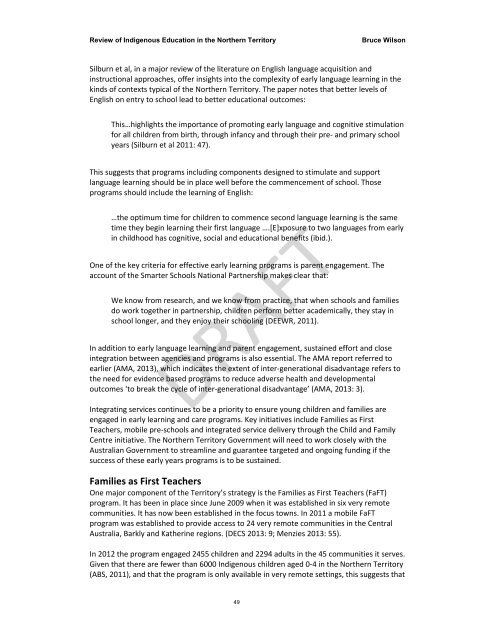Indigenous-Education-Review_DRAFT
Indigenous-Education-Review_DRAFT
Indigenous-Education-Review_DRAFT
You also want an ePaper? Increase the reach of your titles
YUMPU automatically turns print PDFs into web optimized ePapers that Google loves.
<strong>Review</strong> of <strong>Indigenous</strong> <strong>Education</strong> in the Northern Territory<br />
Bruce Wilson<br />
Silburn et al, in a major review of the literature on English language acquisition and<br />
instructional approaches, offer insights into the complexity of early language learning in the<br />
kinds of contexts typical of the Northern Territory. The paper notes that better levels of<br />
English on entry to school lead to better educational outcomes:<br />
This…highlights the importance of promoting early language and cognitive stimulation<br />
for all children from birth, through infancy and through their pre‐ and primary school<br />
years (Silburn et al 2011: 47).<br />
This suggests that programs including components designed to stimulate and support<br />
language learning should be in place well before the commencement of school. Those<br />
programs should include the learning of English:<br />
…the optimum time for children to commence second language learning is the same<br />
time they begin learning their first language ….[E]xposure to two languages from early<br />
in childhood has cognitive, social and educational benefits (ibid.).<br />
One of the key criteria for effective early learning programs is parent engagement. The<br />
account of the Smarter Schools National Partnership makes clear that:<br />
We know from research, and we know from practice, that when schools and families<br />
do work together in partnership, children perform better academically, they stay in<br />
school longer, and they enjoy their schooling (DEEWR, 2011).<br />
In addition to early language learning and parent engagement, sustained effort and close<br />
integration between agencies and programs is also essential. The AMA report referred to<br />
earlier (AMA, 2013), which indicates the extent of inter‐generational disadvantage refers to<br />
the need for evidence based programs to reduce adverse health and developmental<br />
outcomes ‘to break the cycle of inter‐generational disadvantage’ (AMA, 2013: 3).<br />
<strong>DRAFT</strong><br />
Integrating services continues to be a priority to ensure young children and families are<br />
engaged in early learning and care programs. Key initiatives include Families as First<br />
Teachers, mobile pre‐schools and integrated service delivery through the Child and Family<br />
Centre initiative. The Northern Territory Government will need to work closely with the<br />
Australian Government to streamline and guarantee targeted and ongoing funding if the<br />
success of these early years programs is to be sustained.<br />
Families as First Teachers<br />
One major component of the Territory’s strategy is the Families as First Teachers (FaFT)<br />
program. It has been in place since June 2009 when it was established in six very remote<br />
communities. It has now been established in the focus towns. In 2011 a mobile FaFT<br />
program was established to provide access to 24 very remote communities in the Central<br />
Australia, Barkly and Katherine regions. (DECS 2013: 9; Menzies 2013: 55).<br />
In 2012 the program engaged 2455 children and 2294 adults in the 45 communities it serves.<br />
Given that there are fewer than 6000 <strong>Indigenous</strong> children aged 0‐4 in the Northern Territory<br />
(ABS, 2011), and that the program is only available in very remote settings, this suggests that<br />
49


